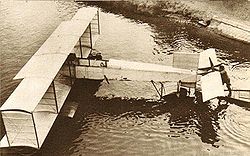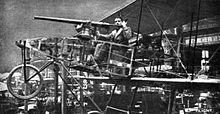Aeroplanes Voisin Video - Picture

|
|
Aeroplanes Voisin

Picture - Canard Voisin seaplane under trial on the Seine, on August 3, 1911. The head of the aircraft is to the right.
Aéroplanes Voisin (also known as Brothers Voisin, French: Les Frx¨res Voisin) was a French aircraft company, one of the first in the world. The company was formed in 1906 by the brothers Charles and Gabriel Voisin. Gabriel had previously collaborated with fellow pioneer Louis Blériot at the Blériot-Voisin company.
Early history

Picture - 1910 experimental two-seater biplane with mitrailleuse fired by the passenger
Gabrial Voisin bought out Louis Blériot and established what was then the Appareils d'Aviation Les Frx¨res Voisin (Voisin Brothers' Flying Machines) with Charles. The company was based at Billancourt, near Paris; "this was the first commercial aircraft factory in Europe". Early Voisin products, Blériot tractor-engined monoplane designs, were unsuccessful. In 1907 the Delagrange No. 1, the first Voisin to adopt the pusher-engined biplane design which would be the company's trademark, was flown. It was followed by the Delagrange No. 2, the first European aircraft to complete a one-kilometer flight. Both machines were built for Leon Delagrange. Henri Farman also flew a Voisin in one of his early record-breaking flights. In 1910, the company built an experimental military aircraft, exhibited at the Paris Air Show, but not put into production. More notable was that same year's Canard Voisin, a seaplane, which became one of the most successful designs of the company. Some eighty aircraft had been built by 1912, when Charles was killed in a motor accident.
Aircraft in World War I
The Type L, or Voisin I, was developed for the French Army's 1912 trials. It performed successfully, and some seventy were built in France, and a small number in Russia, before it was replaced by the Type LA or Voisin III design. A large number of Voisin IIIs followed, production increasing with the outbreak of the First World War. The Voisin III was followed by improved Type LB and Type LBS, or Voisin IV and Voisin V aircraft. The larger Type LC, Voisin VII, followed in 1916, but was not a success and only a hundred were built.
Soon after the outbreak of the First World War, it became apparent that the French aviation industry could not produce aircraft in sufficient numbers to meet military requirements. Manufacturers from other fields became subcontractors, and later license-builders, of the aviation industry's designs. The earliest such partnership was between Louis Breguet and Michelin. Gabriel Voisin was late to this field, although his designs were produced in quantity by Russian licensees. By 1918, Voisin was involved with the Voisin-Lafresnaye company, a major constructor of airframes, and the Voisin-Lefebvre company, a major builder of aircraft engines.
Following the Voisin VII came the more powerful, and more successful, Type LAP and Type LBP, known as the Voisin VIII. This was the French army's main night bomber in 1916-1917, with over one thousand built. The Voisin IX, or Type LC, was an unsuccessful design for a reconnaissance aeroplane, which lost out to the superior Salmson 2 and Breguet 14. The Voisin X, Type LAR and Type LBR, was the Voisin VIII with a more reliable Renault engine in place of the previous Peugeot design. Deliveries were much delayed, but some nine hundred were built by the end of the war.
The last significant Voisin design, the Voisin XII, was successful in trials in 1918, but with the end of the war, no production was ordered. Unlike previous Voisins, the Voisin XII was a large, twin-tractor-engined biplane night bomber, rather more elegant than previous, boxy Voisins.
Voisin X ambulance variant
In 1918, a Voisin X (No. 3500) was used to create the Voisin 'Aerochir' (Ambulance). The aircraft was capable of flying a surgeon, together with an operating table and support equipment, including an x-ray machine and autoclave, into battlefield environments. Eight hundred pounds (360 kg) of equipment could be carried in under-wing panniers.
Post World War I
After 1918, Gabriel Voisin abandoned the aviation industry in favor of automobile construction.
Bibliography
(French) Carlier, Claude, Sera Max®tre du Monde, qui sera Max®tre de l'Air: La Création de l'Aviation militaire franx§aise. Paris: Economica/ISC, 2004. ISBN 2-7178-4918-1
Davilla, James J., & Soltan, Arthur M., French Aircraft of the First World War. Stratford, Connecticut: Flying Machines Press, 1997. ISBN 0-9637110-4-0
Aeroplanes Voisin Pictures and Aeroplanes Voisin for Sale.
Living Warbirds: The best warbirds DVD series.
Source: WikiPedia